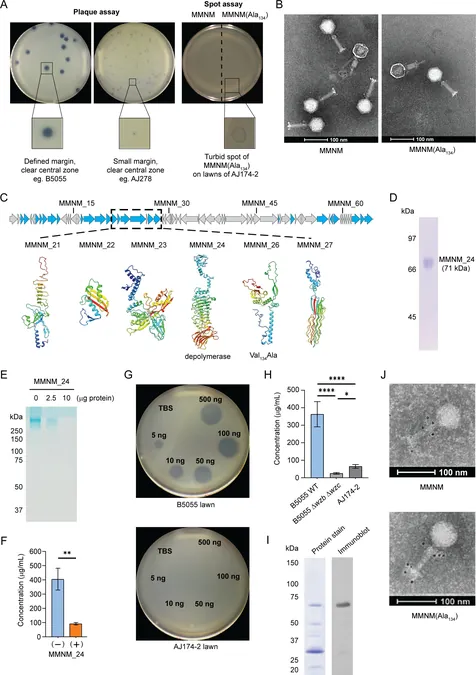
Unveiling a Revolutionary Anti-Viral Defense in Bacteria: Meet CmdTAC!
2024-11-04
Author: Rajesh
In a fascinating advancement that sheds light on the ongoing battle between bacteria and their viral adversaries, researchers have recently defined a new anti-phage defense mechanism known as CmdTAC. This revolutionary discovery reveals how single-celled bacteria—much like humans and other complex organisms—can encounter viral infections and mount a defense against them.
Bacteriophages, commonly referred to as phages, are among the most widespread organisms on Earth, constantly evolving to infect bacterial cells. As these phages battle to bypass bacterial defenses, bacteria race to develop more intricate strategies to protect themselves.
The Intriguing Mechanism of CmdTAC
A study conducted by the Laub Lab at MIT, published in the prestigious journal *Nature*, detailed how CmdTAC alters messenger RNA (mRNA) to thwart viral infection. When a bacteriophage invades, it commandeers the bacterial machinery, triggering an immediate response. In a strategy reminiscent of self-sacrifice, the bacteria engage CmdTAC to halt protein synthesis, thus aborting the virus's production capabilities—though this comes at a cost to the bacterium itself.
Postdoc Christopher Vassallo, co-author of the study, likened this phenomenon to a sacrificial defense mechanism, where one bacterial cell willingly ends its life to protect its neighboring cells in a group. This evolutionary tactic underscores the complex social behavior seen in bacterial populations.
The Role of ADP-Ribosyltransferase
The research highlights the role of an enzyme, ADP-ribosyltransferase, responsible for chemically modifying mRNA. While hundreds of such enzymes have been characterized, this marks the first instance where they’ve been shown to target mRNA. CmdT, one of the components of the CmdTAC system, identifies specific RNA sequences (particularly GA sequences) to modify, effectively disabling the virus’s ability to replicate within the host bacterium.
Untangling the Defense Mechanism
CmdTAC functions as a toxin-antitoxin (TA) system: a structure where the toxin can kill or impede the bacterial cell’s functions, balanced by an antitoxin that neutralizes its effects. During infection, a chaperone protein named CmdC plays a crucial role in detecting the viral presence by sensing the protective protein of the phage, leading to the eventual release of the toxic CmdT. This clever mechanism allows bacteria to effectively identify when they are under attack and respond accordingly.
The Implications of the Discovery
The potential implications of this research extend beyond the microbial world. Senior author Michael Laub suggested that the similarities between bacterial immune responses and those in higher organisms, including humans, may offer groundbreaking insights. The homologs of ADP-ribosyltransferases have been found in human cells, where they are thought to respond to viral infections. This connection beckons the possibility of uncovering universal defensive strategies against pathogens.
As the scientific community delves deeper into microbial immunity, this finding signals a promising frontier in understanding how bacteria not only survive but thrive amid relentless viral threats. The inherent complexity and adaptability of these micro-organisms inspire hope for innovations in medical and agricultural fields, possibly leading to advanced infection control strategies.
Conclusion
In summary, CmdTAC represents a stunning leap in our understanding of bacterial defenses against phages. As researchers continue to decode these intricate mechanisms, we may be on the cusp of unraveling new ways to enhance immunity not only in bacteria but potentially in higher organisms as well. The fight against viral infections could take on a whole new dimension—one where understanding the simplest of life forms reveals profound truths about the biological world.



 Brasil (PT)
Brasil (PT)
 Canada (EN)
Canada (EN)
 Chile (ES)
Chile (ES)
 España (ES)
España (ES)
 France (FR)
France (FR)
 Hong Kong (EN)
Hong Kong (EN)
 Italia (IT)
Italia (IT)
 日本 (JA)
日本 (JA)
 Magyarország (HU)
Magyarország (HU)
 Norge (NO)
Norge (NO)
 Polska (PL)
Polska (PL)
 Schweiz (DE)
Schweiz (DE)
 Singapore (EN)
Singapore (EN)
 Sverige (SV)
Sverige (SV)
 Suomi (FI)
Suomi (FI)
 Türkiye (TR)
Türkiye (TR)